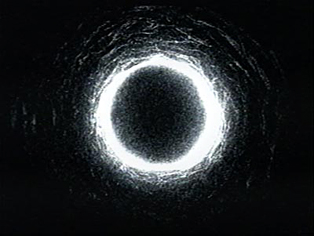A Trinitron® TV is distinguished from the outside by the cylindrical shape of the front of the tube. This cylindrical shape reflects some important internal differences from traditional CRTs that have a roughly spherical shape. When the Trinitron was first introduced, it was a great step forward in color CRT image quality. However, it was followed shortly on by the Zenith innovation of Black Matrix which leveled the playing field. Actually, Black Matrix may have been an enabler for Sony and Trinitron as well as the first Trinitron sets could not show black and white content very well. This was a big draw back in the 1960’s as most of the available content was still Black and White. Applying Black Matrix to Trinitron tubes vastly improved their black and white image quality. As the technology developed the original “aperture grill” inside a Trinitron grew to be more like the “shadow mask” in a conventional CRT. Further detracting from the uniqueness of the Trinitron, Mitsubishi offered a Diamondtron ® set with identical technology.
The Trinitron TV set was first before Black Matrix and before competing Trinitron-like sets. It distinguished Sony in the minds of consumers as providing the best image quality even when their competitors made up the difference. It was neither unique nor all Sony’s technology. Sony also grew its brand image with platform innovations such as the Walkman® and Watchman®. However, when the main stream of television switched from CRTs to flat panels, the Trinitron mark went by the wayside as it seemed to be viewed by the company as a technology rather than an important part of the Sony brand.
Apple
The effective loss of the Trinitron brand coincides with the decline of Sony as the top consumer electronics brand. It also coincides with the emergence of Apple as a mainstream CE brand rather than a computer company. Indeed, Apple’s recent history shares much in common with Sony‘s past glory. Apple introduced the Retina display to the mobile phone market, in-part contributing to a remake of the platform by a significant increase in image quality. Similar to Trinitron, the core of this new brand depends in major part on technological contributions of would-be competitors; Apple does not make LCDs, Samsung does. Apple introduced new platforms, notably the iPod® and iPad®. The iPod directly displaced the Walkman. More importantly, the i-blank meme replaced the blank-man meme in mobile electronics. Where blank-man implied a supreme level of compactness, i-blank implies a supremely developed human interface. As much as the actual technology, what was at stake in the recent patent dispute with Samsung was the i-franchise. Though much of the subsequent commentary centers on a loss of consumer choice and potentially higher prices, the innovations that Apple created and the subsequent brand image where really what was at stake.
Amdahl
Some time ago, I attended a lecture by Gene Amdahl, founder of Amdahl computer. During the lecture, Mr. Amdahl described why he left IBM in order to build supercomputers at his own company. It was not his entrepreneurial spirit but his desired to build really high powered computers, a desire that he could not pursue at IBM at that time. He described a meeting that he had with the pricing manager for IBM mainframes. The pricing manager told how the price structure that IBM had in place for its mainframe product would be destroyed by providing too much computer in one package.
Apple may have a similar issue with the speculated Apple TV Set. While price management was the supercomputer issue at IBM (preventing them from developing an obvious product extension), I believe Apple has a brand management issue with a TV set. Although the Apple name carries considerable panache, as Sony still does, much of the value of the company is in the sub-brands as much of Sony’s value was in Trinitron…. What do you call and Apple branded TV set? Though the delay in launching such a set may be due to inaccurate rumors, technical issues, or the desire to ensure an absolutely distinctive product on first launch, there is some logic that says it is a marketing issue not a technical problem.
iTV already exists in the form of a TV news network. They use the little “i” in their logo as well. The image at the top of this article is the iTV logo from their web page; it demonstrates how an Apple product of the same name could cause confusion as to what the subject is. Retina is also in use of a sort. In the 1983 movie, “Videodrome,” the TV screen is several times referred to as the “Retina of the mind’s eye.” Apple TV is already taken as well, by another Apple product. Apple is free to transfer the brand name from one product to another, as Microsoft recently did with their Surface® brand; however, it seems to be the Apple sub-brands that have the consumers’ attention. Creation of a new brand, either for the TV itself or the TV screen is possible, but brand creation takes money and time. Further, having too many brands or overlapping brands can be damaging to the existing brand structure. Again, what do you call an Apple TV set? For a company that is its branding, this is not a trivial issue. An Apple product without the i-**** or retina co-brand is like a Sony product not labeled Trinitron or ****-man.
WTBS
When I was a student, the school radio station at MIT was WTBS, the “Technology Broadcast Station”. At that time, the FCC mandated an upgrade to low power radio stations and there was no money to upgrade WTBS. The school had obtained an unsolicited offer for its call letters from the New York Times; potentially launching the “Times Broadcast Station”; however the Times offered no money for the deal. Ted Turner offered a much better deal, paying for the school radio station upgrades with some money left over. Hence we now have the WTBS that everyone is familiar with. At MIT, WTBS was not a business, not a profit center. The objectives of those involved with the station were just to keep it on the air. The iTV network is an ongoing business that has been building their brand since the 1950’s…. Wonder what their stock sells for these days?











